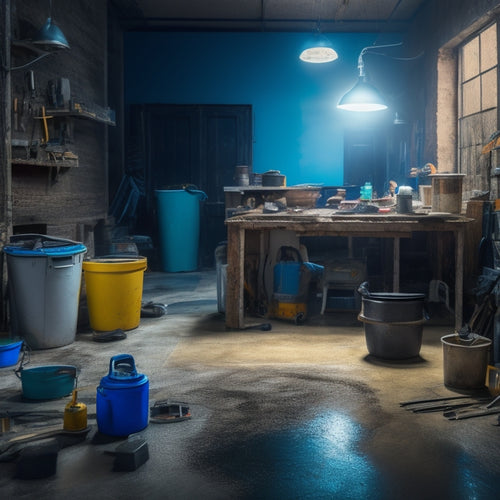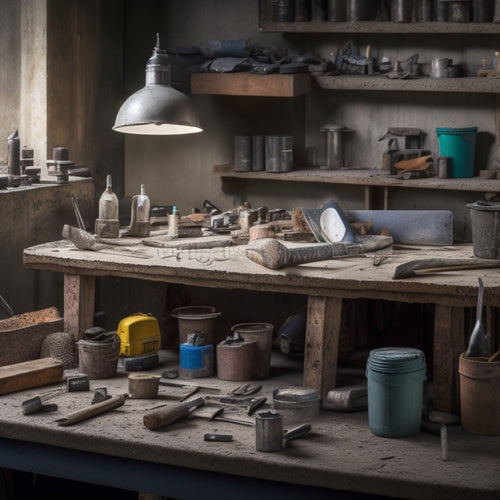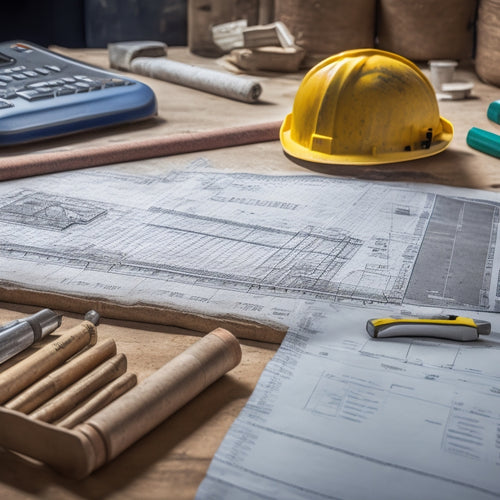
Selecting the Right Tools for Concrete Home Interiors
Share
When selecting the right tools for your concrete home interior project, you'll need to take into account the tasks at hand, from preparation to finishing and design. Start with essential tools like concrete scrapers, grinders, and vacuums to prepare the surface. For finishing and polishing, you'll need tools like diamond grinding pads and polishing compounds to achieve a high-gloss finish. Specialized tools like stencil mats and stamping mats can help you create unique designs. Don't forget safety equipment and gear, as well as power tools for demolition. With the right tools, you'll be well-equipped to tackle your project - and that's just the starting point for bringing your vision to life.
Key Takeaways
• Essential tools like concrete scrapers, grinders, and patching compounds prepare surfaces for finishing and polishing.
• Polishing tools and techniques, such as diamond grinding pads and densification, achieve high-gloss finishes and enhance durability.
• Specialized tools like stencil mats, stamping mats, and texture mats create unique designs and patterns for interior appeal.
• Safety equipment and gear, including protective gear and first-aid kits, ensure a safe working environment and prioritize health investment.
• Power tools like jackhammers, demolition hammers, and concrete saws efficiently demolish and remove old concrete for new interior installations.
Essential Tools for Preparation
You'll need a solid arsenal of essential tools to properly prepare your concrete interior for finishing, starting with a reliable concrete scraper for removing old adhesives, paint, or other substances. This scraper will help you achieve a smooth surface, critical for successful surface preparation.
Next, you'll need a concrete grinder or sanding block to further refine the surface, removing any imperfections and creating a uniform texture. Don't forget a dustless vacuum or wet/dry vacuum to contain and remove dust and debris, guaranteeing a clean working environment.
When it comes to material selection, choose a high-quality concrete patching compound to fill any cracks or holes. This will guarantee a strong, durable bond between the concrete and your chosen finish.
Additionally, consider investing in a concrete sealer or primer to enhance the surface's receptivity to your finish of choice.
With these essential tools and materials at your disposal, you'll be well-equipped to tackle even the most complex surface preparation tasks, setting the stage for a successful and stunning concrete interior.
Concrete Finishing and Polishing
With the surface preparation complete, it's time to focus on concrete finishing and polishing, where the right tools and techniques will transform your interior space into a stunning, high-gloss masterpiece.
You'll need to decide on the desired concrete texture techniques, such as exposed aggregate, salt finish, or acid staining, to achieve the desired aesthetic. Once you've chosen your technique, it's crucial to select the right polishing methods to bring out the best in your concrete.
You'll need to invest in a range of polishing tools, including diamond grinding pads, polishing compounds, and burnishing machines. These tools will help you achieve a high-gloss finish that showcases the beauty of your concrete.
For a more advanced finish, consider using advanced polishing methods like densification or crystallization. These techniques won't only enhance the appearance of your concrete but also improve its durability and resistance to stains.
Specialized Tools for Design
To take your concrete design to the next level, specialized tools for design, such as stencils, stamping mats, and texture mats, become essential for creating intricate patterns, textures, and designs that enhance the aesthetic appeal of your interior space.
These tools allow you to achieve unique concrete textures and design aesthetics that set your space apart from the rest.
Here are some specialized tools you'll want to evaluate:
-
Stencil mats: Create intricate patterns and designs with stencil mats, which can be custom-made to fit your unique design vision.
-
Stamping mats: Add texture and depth to your concrete with stamping mats, which can mimic the look of natural stone or other materials.
-
Texture mats: Achieve a variety of textures, from smooth to rough, with texture mats that can be used to create unique design elements.
- Pattern stampers: Use pattern stampers to create repeating patterns, such as chevrons or herringbone, that add visual interest to your concrete design.
Safety Equipment and Gear
Protecting yourself from concrete's abrasive nature and the physical demands of working with it requires investing in essential safety equipment and gear.
As you work on your concrete home interior, you'll be exposed to dust, debris, and harsh chemicals, which can cause serious harm if you're not properly safeguarded. Start by investing in high-quality protective gear, including safety glasses, gloves, and a dust mask. These will protect your eyes, skin, and lungs from the hazards of concrete work.
Next, establish safety protocols for your workspace. This includes setting up a well-ventilated area, using drop cloths or tarps to contain messes, and keeping a fire extinguisher on hand. You should also have a first-aid kit nearby in case of accidents.
Remember to regularly inspect your equipment and gear to verify they're in good condition. By prioritizing safety, you'll be able to focus on creating a stunning concrete interior without worrying about your well-being.
Don't compromise on safety – it's an investment in your health and the success of your project.
Power Tools for Demolition
You'll need a range of power tools to tackle demolition tasks efficiently, such as breaking up existing flooring, removing old walls, or demolishing concrete surfaces. When it comes to demolition, the right tools can make all the difference regarding speed, safety, and effectiveness.
Here are some essential power tools to take into account:
-
Jackhammers vs. Sledgehammers: Jackhammers are ideal for breaking up concrete surfaces, while sledgehammers are better suited for smaller, more precise demolition tasks.
-
Demolition Hammers: These heavy-duty tools are designed for heavy demolition work and can deliver high impact forces.
-
Concrete Saws: These saws are perfect for cutting through concrete, asphalt, and other hard materials.
- Dust Extraction Systems: These systems are vital for minimizing dust and debris on-site, ensuring a safer and healthier working environment.
Frequently Asked Questions
Can Concrete Be Used for Interior Walls and Ceilings, Not Just Floors?
You're wondering if concrete is limited to floors only, right? Not at all!
You can use concrete for interior walls and ceilings too, and it's a game-changer. With advancements in concrete textures and decorative finishes, you can achieve a unique, industrial-chic look that's both durable and stylish.
Imagine exposed concrete walls with a polished finish or a decorative stamped ceiling - the possibilities are endless, and the result is a truly innovative space that showcases your personal style.
How Do I Ensure Color Consistency Across the Entire Concrete Surface?
'Oh, you want to achieve color consistency? Good luck with that, it's not like you're trying to solve world hunger or anything!
But seriously, to guarantee a uniform hue, you'll need to master the art of color mixing. Invest in a high-quality mixer and follow a strict ratio guideline.
After application, apply a surface sealer to lock in the color and protect the concrete. Voilà! Consistency achieved.
Now, go forth and create a concrete masterpiece that'll make the world swoon.'
Can I Use Concrete for Countertops and Kitchen Islands?
You're considering concrete for countertops and kitchen islands, and that's a great choice!
Concrete durability is unmatched, making it perfect for high-traffic areas. However, you'll need to commit to regular countertop maintenance to keep it looking its best.
With the right sealers and cleaning products, you can enjoy a stunning, low-maintenance surface that'll last for years.
Just be prepared to invest time in upkeep, and you'll be rewarded with a unique, industrial-chic look that'll elevate your kitchen's style.
Are There Any Eco-Friendly Alternatives to Traditional Concrete Materials?
You're likely looking for eco-friendly alternatives to traditional concrete materials.
Consider sustainable concrete made with recycled aggregates, reducing waste and environmental impact.
These innovative materials offer similar strength and durability to traditional concrete while promoting a greener future.
You can explore options like recycled glass or fly ash-based concretes, which not only benefit the environment but also provide unique aesthetic appeal for your home interior projects.
How Long Does It Take to Complete a Concrete Home Interior Project?
You're about to commence on a concrete home interior project that'll take you on a wild ride, lasting an eternity... or so it may seem!
In reality, the project timeline depends on various factors, including the scope, complexity, and your workflow efficiency. A typical project can take anywhere from a few weeks to several months.
To guarantee a smooth ride, prioritize planning, and optimize your workflow to minimize delays and maximize productivity.
Conclusion
As you wrap up your concrete home interior project, remember that having the right tools is like holding the keys to a treasure chest - it reveals the full potential of your design.
Don't skimp on quality or settle for mediocre results. Invest in the essential tools for preparation, finishing, and polishing.
Don't forget safety gear and power tools for demolition.
With the right arsenal, you'll be able to tackle any concrete interior project with confidence and precision.
Related Posts
-

Essential Tools for Epoxy Concrete Floor Repair
You'll need a thorough arsenal of specialized tools to guarantee a successful epoxy concrete floor repair. Floor prep...
-

Top Tools for Concrete Repair Success
When it comes to concrete repair success, you'll need a well-stocked toolkit with essential hand tools like trowels, ...
-

5 Tips for Accurate Concrete Measurement Tools
To guarantee accurate concrete measurement, you'll want to calibrate your measuring tools regularly, choosing a frequ...


